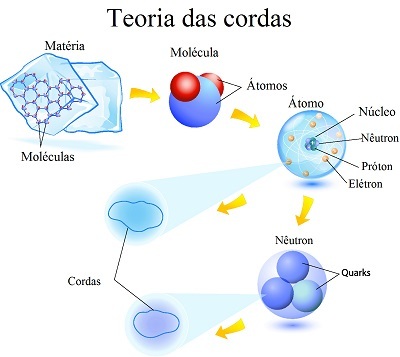The 20th century was extremely important for the development of science and for understanding the composition of the Universe. This happened thanks to the development of the most complete theories ever created to describe the structure of the universe: a general relativity, in Albert Einstein, and the Quantum physics.
Despite the success of these theories, they left some questions open. First, general relativity cannot explain the theory of big Bang nor the behavior of black holes. Second, Quantum Physics does not offer a satisfactory explanation for the gravitation.
THE string theorywas developed in an attempt to unify these two main theories of Modern Physics. It began to be developed in 1919, by Theodor Kaluza, and continues to evolve. The latest innovation was proposed by Edward Witten between 1994 and 1997.
What is string theory?
If you look at a desert at a certain point, what you will see is a continuous space whose color will depend on the color of the sand that makes it up. But if you get close to this desert, you will see that it is made up of tiny grains of sand. These grains, in turn, are made up of even smaller particles that are invisible to the naked eye:
the atoms. These have their structure formed by electrons, protons and neutrons. Protons and neutrons are formed from elementary particles called quarks. This is where conventional physics goes. String theory goes a little further.According to the string theory, you quarks are formed by small filaments of energy similar to small vibrant strings, hence the name given to the theory. These strings would be vibrating in different patterns, with different frequencies, producing the different particles that make up our world. Note the scheme in the figure below:

The figure shows that if the matter is broken down into its smallest parts, we will see that it is made up of small strings.
For ease of understanding, we can draw an analogy between these strings and the strings of a guitar: Just as the different vibrations of guitar strings produce different sounds, the vibrations of these little strands of energy produce different particles.
By stating that everything that makes up the universe is made up of a single form, string theory manages to unify all theories of physics. Since all the particles that make up matter are made up of just one entity, they can all be explained by just one theory. That's why string theory can also be called theory of all things(Theory of Everything- TOE).
String Theory Implications
THE main consequence of string theory it's in his mathematical proof: it doesn't work in a universe with three spatial dimensions, but in one with ten dimensions of space and one of time! This means that, if the theory is proven, there are seven spatial dimensions that we cannot perceive and that go beyond height, length and width. This represents a new view of the Universe quite different from what we already know.
Despite all the advances already presented, string theory is still just an idea and cannot be demonstrated experimentally. It is expected that, with the advancement of research around the particle accelerators, it will be possible to prove it in the coming years.
By Mariane Mendes
Graduated in Physics
Source: Brazil School - https://brasilescola.uol.com.br/fisica/teoria-das-cordas.htm

